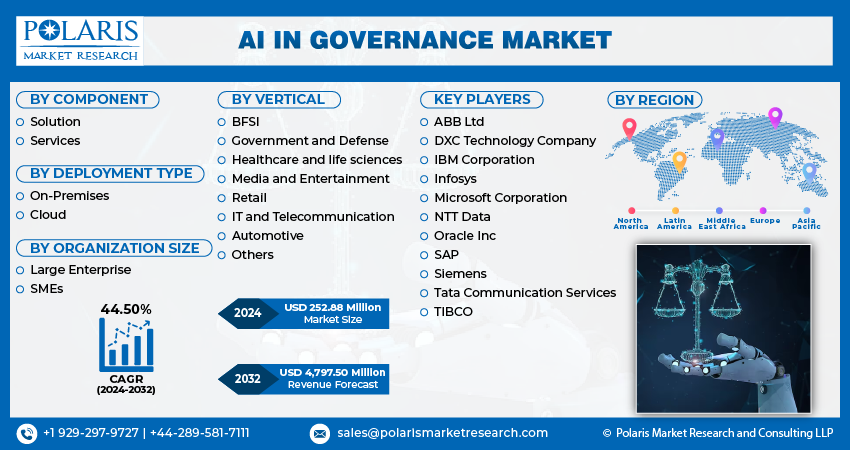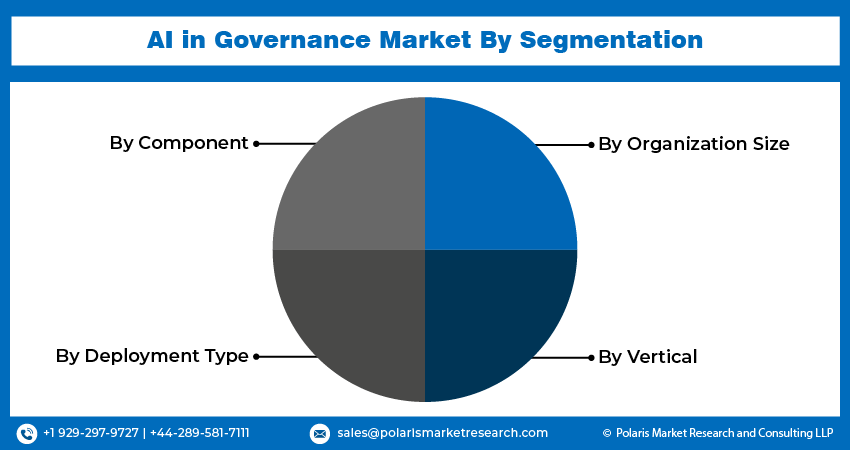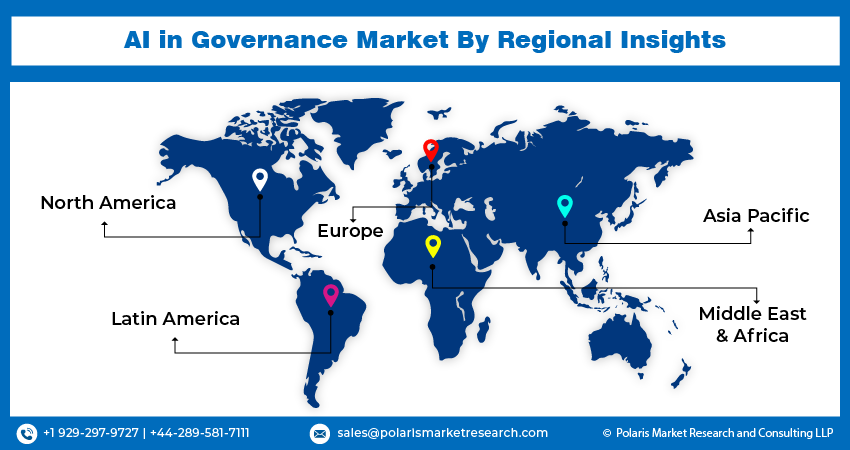
AI in Governance Market Size, Share, Trends, & Industry Analysis Report
: By Component (Solution and Services), By Deployment, By Organization Size, By Vertical, and By Region – Market Forecast, 2025–2034
- Published Date:Jun-2025
- Pages: 115
- Format: PDF
- Report ID: PM3567
- Base Year: 2024
- Historical Data: 2020-2023
The AI in governance market size was valued at USD 225.03 million in 2024, exhibiting a CAGR of 35.5% during 2025–2034.
The AI in Governance market is driven by increasing regulatory requirements, rising adoption of AI technologies, and a growing emphasis on ethical AI practices, necessitating robust governance frameworks to ensure responsible deployment.
Market Overview
Artificial intelligence (AI) in governance market refers to the application of AI technologies within governmental and public sector operations. It encompasses the use of machine learning, natural language processing, and other AI techniques to enhance efficiency, improve decision-making, and deliver better public services. The market is witnessing significant growth, driven by several factors. One key driver is the increasing need for governments to manage and analyze vast amounts of data effectively. AI offers powerful tools for data processing, enabling insights that can lead to more informed policy formulation and resource allocation. Furthermore, the growing demand for enhanced public service delivery is propelling development. AI-powered solutions can automate routine tasks, personalize citizen interactions, and streamline bureaucratic processes, ultimately improving the citizen experience.

To Understand More About this Research: Request a Free Sample Report
Another significant driver is the rising emphasis on transparency and accountability in governance. AI can facilitate these objectives by providing audit trails, improving the explainability of decision-making processes, and detecting potential biases in existing systems. This increased transparency can foster greater public trust in government operations. Additionally, the increasing complexity of societal challenges, such as climate change and public health crises, necessitates advanced analytical capabilities that AI can provide. The market outlook for AI in governance is positive, with a forecast indicating substantial growth as governments worldwide recognize the transformative potential of AI to modernize their operations and better serve their citizens. This potential is further amplified by ongoing technological advancements and decreasing costs associated with AI implementation.
Industry Dynamics
Increasing Need for Efficient Data Management
Governments around the world are dealing with a growing amount of data from many sources, such as interactions with citizens, sensor systems, and daily administrative tasks. AI data management offers sophisticated capabilities for managing and extracting valuable insights from this data deluge. According to a publication by the National Institute of Standards and Technology (NIST) in 2023, AI algorithms can be employed for advanced data analytics, enabling governments to identify trends, predict outcomes, and make data-driven decisions more effectively. For instance, AI in healthcare can analyze traffic patterns to optimize urban planning or process healthcare data to identify disease outbreaks. This enhanced ability to manage and utilize complex datasets is a significant driver, as it empowers governments to improve operational efficiency and policy outcomes.
Growing Demand for Enhanced Public Service Delivery
Citizens increasingly expect seamless and personalized public services similar to the experiences offered by the private sector. AI technologies are instrumental in meeting these evolving expectations by enabling automation, personalization, and improved accessibility of government services. The "Digital India" initiative highlights the government's focus on leveraging technology to enhance citizen services, as mentioned in a press release by the Press Information Bureau (PIB) in 2025. AI-powered chatbots can provide instant responses to citizen queries, while AI-driven platforms can streamline application processes for various government schemes. By improving the speed, convenience, and quality of public service delivery, the demand for AI solutions is significantly contributing to the growth.
Rising Emphasis on Transparency and Accountability
Maintaining public trust requires governments to be transparent in their operations and accountable for their decisions. AI can play a crucial role in fostering transparency and accountability by providing clear audit trails and enhancing the explainability of decision-making processes. NIST, in its 2024 guidelines on trustworthy and responsible AI, emphasizes the importance of explainability and transparency in AI systems used in the public sector. AI also aids in detecting and preventing corruption by analyzing large datasets to identify anomalies and potential fraudulent activities. This increasing focus on ensuring transparency and accountability in governmental functions is a key driver, leading to greater adoption of AI in governance solutions.

Segmental Insights
Market Assessment By Component
The AI in governance market is segmented by component into solution and services. Currently, the solution subsegment holds the highest share. This dominance can be attributed to the foundational nature of AI-powered software platforms and tools that directly address various governmental needs. These solutions encompass a wide array of applications, including data analytics platforms, intelligent automation tools, and AI-driven decision support systems. The substantial investment by governments in acquiring and implementing these core AI solutions to modernize their infrastructure and processes has resulted in this segment capturing the largest portion. The fundamental requirement for these technological tools across diverse government functions solidifies the solution subsegment's leading position.
The services subsegment is anticipated to exhibit the highest growth rate. This rapid expansion is driven by the increasing need for specialized expertise to effectively deploy, integrate, and maintain complex AI solutions. Governments often require external support for tasks such as consulting, system integration, training, and ongoing technical assistance to maximize the benefits of their AI investments. As the adoption of AI technologies deepens and becomes more sophisticated across various government agencies, the demand for these specialized services is expected to surge. This growing reliance on expert guidance and support to navigate the complexities of AI implementation positions the services subsegment for the highest growth.
Market Evaluation By Deployment
The AI in governance market is segmented by deployment into on-premises and cloud. Currently, the on-premises deployment model holds the largest share. This significant share is primarily due to the stringent data security and compliance requirements prevalent in many government sectors. Historically, governments have favored maintaining direct control over their data and IT infrastructure, leading to substantial investments in on-premises AI deployments. This preference for local infrastructure ensures adherence to specific regulatory frameworks. It provides a perceived higher level of security for sensitive government data, thus establishing on-premises as the dominant deployment type.
The cloud deployment model is expected to experience the highest growth rate. This rapid growth is fueled by the increasing recognition of the scalability, flexibility, and cost-effectiveness offered by cloud-based AI solutions. Cloud deployments enable governments to access advanced AI capabilities without significant upfront infrastructure investments and allow for easier scaling of resources based on evolving needs. Furthermore, advancements in cloud security and the development of government-specific cloud platforms are addressing previous concerns regarding data security. This shift towards leveraging the agility and efficiency of the cloud is positioning it as the fastest-growing deployment model.
Market Evaluation By Organization Size
The AI in governance market is segmented by organization size into large enterprise and SMEs. Currently, the large enterprise segment accounts for the highest share. This dominance is primarily attributed to the substantial investments undertaken by large governmental bodies and public sector organizations in implementing comprehensive AI solutions. These large-scale entities often have the resources and complex operational requirements that necessitate sophisticated AI deployments across various departments and functions. Their early adoption of advanced technologies and significant budgetary allocations for digital transformation initiatives have established large enterprises as the leading segment in terms of share.
The SMEs segment is anticipated to demonstrate the highest growth rate. This rapid growth is driven by the increasing availability of cost-effective and user-friendly AI solutions tailored to the specific needs and budgets of smaller government agencies and public sector undertakings. The growing recognition of the benefits of AI in enhancing efficiency and service delivery, coupled with the emergence of accessible AI platforms, is enabling SMEs to adopt these technologies at an accelerated pace. This increasing penetration of AI within smaller governmental units is expected to make the SME segment the fastest-growing segment.
Market Evaluation By Vertical
The AI in governance market is segmented by vertical into BFSI, government & defense, healthcare & life sciences, media & entertainment, retail, it & telecommunication, automotive, and others. Currently, the government & defense vertical holds the largest share. This dominance is primarily due to the significant investments made by governmental bodies and defense organizations globally to enhance national security, improve public services, and streamline administrative processes. The critical nature of operations within this vertical, coupled with substantial budgetary allocations for technological advancements, has led to the widespread adoption of AI solutions for applications such as cybersecurity, intelligence analysis, and citizen management, establishing government & defense as the leading segment.
The healthcare & life sciences vertical is anticipated to experience the highest growth rate. This rapid expansion is driven by the increasing recognition of AI's potential to revolutionize healthcare delivery, drug discovery, and public health management. AI-powered tools for disease diagnosis, personalized medicine, and efficient healthcare administration are gaining traction. Furthermore, government initiatives worldwide are promoting the adoption of digital health technologies, creating a significant demand for AI in this sector. The transformative potential of AI to improve patient outcomes and optimize healthcare systems positions healthcare & life sciences as the vertical with the highest growth prospects.

Regional Analysis
North America AI in governance market currently holds the largest share. This dominance can be attributed to the region's advanced technological infrastructure, significant government investments in research and development, and a proactive approach towards digital transformation in the public sector. The presence of leading technology providers and a strong focus on innovation have facilitated the early adoption and widespread implementation of AI solutions across various government agencies in North America. Furthermore, stringent regulatory frameworks and a strong emphasis on data security have also shaped the deployment of sophisticated AI technologies, contributing to the region's leading position.
The Asia Pacific AI in governance market is projected to exhibit the highest growth rate. This rapid expansion is fueled by increasing government initiatives towards digitalization, a burgeoning technological landscape, and a growing awareness of the potential of AI to address societal challenges and improve governance. Countries in this region are making significant investments in smart city projects, digital public infrastructure, and AI-driven citizen services. The large population base and the increasing adoption of advanced technologies across various sectors are creating substantial potential, positioning Asia Pacific as the region with the most promising growth prospects.

Key Players and Competitive Insights
Some of the major players in the AI in governance market include Microsoft Corporation, International Business Machines Corporation (IBM), Amazon Web Services, Inc. (Amazon.com, Inc.), Google LLC (Alphabet Inc.), SAP SE, Oracle Corporation, Palantir Technologies Inc., C3.ai, Inc., SAS Institute Inc., and NVIDIA Corporation. These entities are actively involved in providing AI solutions and services tailored for government and public sector applications.
The competitive landscape is characterized by a mix of established technology giants and specialized AI vendors. Competition is intensifying as organizations recognize the transformative potential of AI in enhancing governmental operations and public services. Key areas of competition include the development of innovative AI algorithms, the ability to provide secure and compliant solutions, and the expertise in addressing the unique challenges and requirements of the public sector. Market insights suggest that strategic partnerships, collaborations with government agencies, and a focus on developing tailored solutions are crucial for companies to gain a competitive edge in this evolving market.
List of Key Companies in AI in Governance Industry:
- Amazon Web Services, Inc.
- C3.ai, Inc.
- Google LLC (Alphabet Inc.)
- International Business Machines Corporation (IBM)
- Microsoft Corporation
- NVIDIA Corporation
- Oracle Corporation
- Palantir Technologies Inc.
- SAP SE
- SAS Institute Inc.
AI in Governance Industry Developments
- October 2024: Microsoft introduced new AI features designed for healthcare providers. These included a service allowing companies to develop specialized AI agents for tasks such as scheduling appointments and matching patients to clinical trials. Additionally, Microsoft rolled out foundational models for medical imaging and a platform for analyzing healthcare data.
- May 2024: IBM Corporation collaborated with Amazon Web Services (AWS) to integrate its watsonx governance platform with Amazon SageMaker. This partnership enables businesses to scale their AI solutions while maintaining robust governance and compliance, particularly in response to evolving regulatory landscapes.
AI in Governance Market Segmentation
By Component Outlook (Revenue – USD Million, 2020–2034)
- Solution
- Services
By Deployment Outlook (Revenue – USD Million, 2020–2034)
- On-Premises
- Cloud
By Organization Size Outlook (Revenue – USD Million, 2020–2034)
- Large Enterprise
- SMEs
By Vertical Outlook (Revenue – USD Million, 2020–2034)
- BFSI
- Government & Defense
- Healthcare & life sciences
- Media & Entertainment
- Retail
- IT & Telecommunication
- Automotive
- Others
By Regional Outlook (Revenue-USD Million, 2020–2034)
- North America
- US
- Canada
- Europe
- Germany
- France
- UK
- Italy
- Spain
- Netherlands
- Russia
- Rest f Europe
- Asia-Pacific
- China
- Japan
- India
- Malaysia
- Suth Korea
- Indnesia
- Australia
- Vietnam
- Rest f Asia-Pacific
- Middle East & Africa
- Saudi Arabia
- UAE
- Israel
- Suth Africa
- Rest f Middle East & Africa
- Latin America
- Mexic
- Brazil
- Argentina
- Rest f Latin America
AI in Governance Market Report Scope:
|
Report Attributes |
Details |
|
Market Size Value in 2024 |
USD 225.03 million |
|
Market Size Value in 2025 |
USD 304.36 million |
|
Revenue Forecast by 2034 |
USD 4,686.36 million |
|
CAGR |
35.5% from 2025 to 2034 |
|
Base Year |
2024 |
|
Historical Data |
2020–2023 |
|
Forecast Period |
2025–2034 |
|
Quantitative Units |
Revenue in USD million and CAGR from 2025 to 2034 |
|
Report Coverage |
Revenue Forecast, Market Competitive Landscape, Growth Factors, and Industry Insights |
|
Segments Covered |
|
|
Regional Scope |
|
|
Competitive Landscape |
|
|
Report Format |
|
|
Customization |
Report customization as per your requirements with respect to countries, regions, and segmentation. |
How is the report valuable for an organization?
Workflow/Innovation Strategy: The AI in governance market has been segmented into detailed segments of component, deployment, organization size, and vertical. Moreover, the study provides the reader with a detailed understanding of the different segments at both the global and regional levels.
Market Entry Strategies: A successful growth strategy necessitates a multi-faceted approach. Emphasizing the tangible benefits of AI in enhancing efficiency, transparency, and citizen services is crucial for penetration. Targeted marketing efforts should highlight successful government implementations and address specific pain points within various public sector verticals. Building trust through robust data security measures and ethical AI frameworks will be essential for wider adoption. Strategic collaborations with government agencies and system integrators can facilitate entry assessments and accelerate development.
FAQ's
The global market size was valued at USD 225.03 million in 2024 and is projected to grow to USD 4,686.36 million by 2034.
The market is projected to register a CAGR of 35.5% during the forecast period, 2024-2034.
North America had the largest share of the market.
Some of the major players include Microsoft Corporation, International Business Machines Corporation (IBM), Amazon Web Services, Inc. (Amazon.com, Inc.), Google LLC (Alphabet Inc.), SAP SE, Oracle Corporation, Palantir Technologies Inc., C3.ai, Inc., SAS Institute Inc., and NVIDIA Corporation.
The solution segment accounted for the larger share of the market in 2024.
Following are some of the trends: ? Increasing Regulatory Scrutiny: Governments worldwide are focusing on establishing regulations and frameworks to govern the development and deployment of AI, such as the EU's AI Act. This is driving the need for AI governance solutions to ensure compliance. ? Growing Emphasis on Ethical AI: There is a rising concern regarding the ethical implications of AI, including issues like algorithmic bias and lack of transparency. This is leading to a greater demand for AI governance tools that promote fairness and accountability.
AI in Governance refers to the application of artificial intelligence technologies within the public sector to improve efficiency, decision-making, and service delivery. It involves using AI tools and techniques like machine learning and natural language processing to analyze data, automate tasks, and provide insights for government operations and policy formulation. The goal is to leverage AI's capabilities to enhance governance processes and outcomes for citizens and the government itself.
